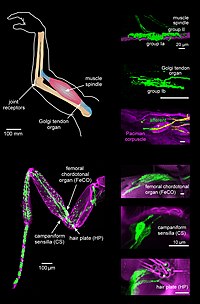
Photo from wikipedia
Tinnitus is thought to be triggered by aberrant neural activity in the central auditory pathway and is often accompanied by comorbidities of emotional distress and anxiety, which imply maladaptive functional… Click to show full abstract
Tinnitus is thought to be triggered by aberrant neural activity in the central auditory pathway and is often accompanied by comorbidities of emotional distress and anxiety, which imply maladaptive functional connectivity to limbic structures, such as the amygdala and hippocampus. Tinnitus patients with normal audiograms can also have accompanying anxiety and depression, clinically. To test the role of functional connectivity between the central auditory pathway and limbic structures in patients with tinnitus with normal audiograms, we developed a murine noise-induced tinnitus model with a temporary threshold shift (TTS). Tinnitus mice exhibited reduced auditory brainstem response wave I amplitude, and an enhanced wave IV amplitude and wave IV/I amplitude ratio, as compared with control and non-tinnitus mice. Resting-state functional magnetic resonance imaging (fMRI) was used to identify abnormal connectivity of the amygdala and hippocampus and to determine the relationship with tinnitus characteristics. We found increased fMRI responses with amplitude of low-frequency fluctuation (ALFF) in the auditory cortex and decreased ALFF in the amygdala and hippocampus at day 1, but decreased ALFF in the auditory cortex and increased ALFF in the amygdala at day 28 post-noise exposure in tinnitus mice. Decreased functional connectivity between auditory brain regions and limbic structures was demonstrated at day 28 in tinnitus mice. Therefore, aberrant neural activities in tinnitus mice with TTS involved not only the central auditory pathway, but also limbic structures, and there was maladaptive functional connectivity between the central auditory pathway and limbic structures, such as the amygdala and hippocampus.
Journal Title: Neuroscience
Year Published: 2019
Link to full text (if available)
Share on Social Media: Sign Up to like & get
recommendations!